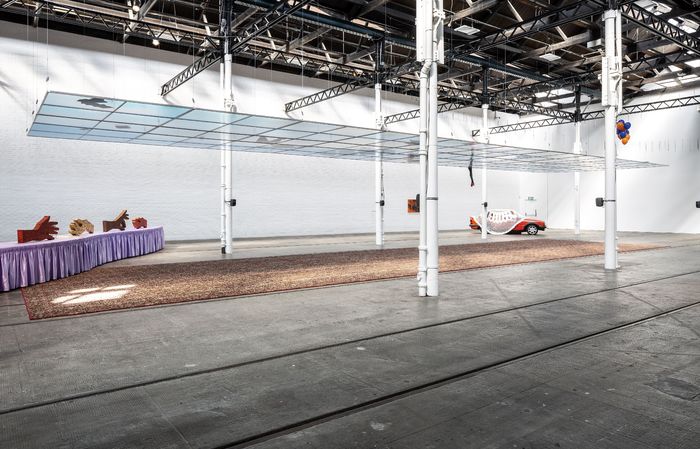Tate Modern’s Electric Dreams: beyond the visual
The Tate Modern’s most recent exhibition leads us back to the future, showcasing how artists imagined technology’s development and its effect on sensation

Arts and Sciences have long been seen as two opposing disciplines. Yet Tate Modern’s newest exhibition deconstructs this idea, exploring Computer Science, Chemistry, Maths and Engineering alongside visual art. The works exhibited here cover a broad geographic range, from the German group ZERO, to Korean artists such as Nam June Paik. Many of these globally-renowned works are being shown in the UK for the first time. Equally, the exhibition has great variety in terms of decades showcased, moving from experiments with light and sound in the 1950s, through to video-game based art of the 1990s.

A mathematical approach to art is evident throughout the exhibition, including in a copy of a book containing Brion Gysin’s poem I am that I am (1960). Using digital algorithms, Gysin produces permutational poetry, based around the phrase “I am that I am”, assigning each word a symbol and then re-arranging the words of the phrase in each line. Mixing multiple forms of media, other examples of Gysin’s work exhibited in Electric Dreams include Dreamachine no.9 (1960-76), a work that deconstructs notions of vision. A cylinder with multiple holes, as it spins, the Dreamachine emanates pulsating light waves. It is unique in the sense that it is designed to be experienced with closed eyes, where patterns appear on the eyelid.
"Art is not defined as simply visual, but audible, tangible and even wearable"
The concept of ‘art’ is further deconstructed through the use of multiple senses – art is not defined as simply visual, but audible, tangible, and even wearable. The striking photos of Atsuko Tanaka’s Electric Dress (1957), accompanied by her circuit-like drawings, are more reminiscent of a physics lesson than a costume design. Yet, the accompanying description, highlighting the risk that this dress posed to its wearer, serves as a reminder of the lengths artists will go to in order to push the limits of what defines their creativity. Risking electrocution, Tanaka epitomises the creativity and experimental desires of the artists whose work is exhibited in Electric Dreams.
The most surprising aspect of Electric Dreams, in my eyes, can be found in section 11, named Electronic DIY. Consisting mostly of televisions, computers and video games, this room houses Nam June Paik’s video synthesiser. According to the artist himself, this work, visually difficult to comprehend, is best seen when accompanied by the Beatles’ discography. Slightly confused, I put on the headset and found that listening to All my Loving felt like a connection between myself and the artist. These moments, I think, are what make this exhibition so successful: it blends the technologically advanced with a simple enthusiasm for art that will inspire even those of us who lack a mathematical background.

Following the constructed layout of the exhibition, which is arranged in a broadly chronological order, one of the final pieces you encounter is Monika Fleischmann and Wolfgang Strauss’ Liquid Views (1992), which achieves what the other pieces in this exhibition have implied; the viewer is not merely a spectator, but an active participant. In this piece, a video camera captures the viewer’s image and reflects it onto a touchscreen which depicts a pool of water. To look at Liquid Views is to become a part of the artwork.
Whilst focusing on 20th-century art and technology, this exhibition is extremely relevant to current discussions regarding the future impacts of technology upon art. Fears about the influence of AI upon artistic freedom are growing rapidly; worse still, they may be justified, as last month a portrait of Alan Turing produced by an AI robot sold for more than 1 million USD. But Electric Dreams ultimately serves as a reminder that art flourishes not when we fight against technology, but when we embrace the changes and advancements that technology can bring to our society. The influence of modernisation upon art is nothing unexpected, as art has always taken inspiration from the world around it: if the world changes, art will too.
‘Electric Dreams: Art and Technology Before the Internet’ is open at Tate Modern from 28 November 2024 – 1 June 2025.
 Comment / Cambridge students are too opinionated 21 April 2025
Comment / Cambridge students are too opinionated 21 April 2025 Interviews / Meet the Chaplain who’s working to make Cambridge a university of sanctuary for refugees20 April 2025
Interviews / Meet the Chaplain who’s working to make Cambridge a university of sanctuary for refugees20 April 2025 News / News in brief: campaigning and drinking20 April 2025
News / News in brief: campaigning and drinking20 April 2025 Comment / Cambridge’s tourism risks commodifying students18 April 2025
Comment / Cambridge’s tourism risks commodifying students18 April 2025 Comment / Cambridge’s gossip culture is a double-edged sword7 April 2025
Comment / Cambridge’s gossip culture is a double-edged sword7 April 2025






